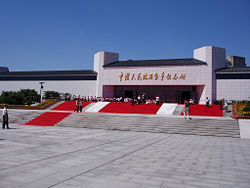http://www.newworldencyclopedia.org/entry/Second_Sino-Japanese_War
Legacy: Who fought the War of Resistance?
The question as to which political group directed the Chinese war effort and exerted most of the effort to resist the Japanese remains a controversial issue.
In the Chinese People's War of Resistance Against Japan Memorial near the Marco Polo Bridge and in mainland Chinese textbooks, the People's Republic of China (PRC) claims that it was the Communist Party that directed Chinese efforts in the war and did everything to resist the Japanese invasion. Recently, however, with a change in the political climate, the CCP has admitted that certain Nationalist generals made important contributions in resisting the Japanese. The official history in mainland China is that the KMT fought a bloody, yet indecisive, frontal war against Japan, while it was the CCP that engaged the Japanese forces in far greater numbers behind enemy lines. This emphasis on the CCP's central role is partially reflected by the PRC's labeling of the war as the Chinese People's Anti-Japanese War of Resistance rather than merely the War of Resistance. According to the PRC official point of view, the Nationalists mostly avoided fighting the Japanese in order to preserve its strength for a final showdown with the Communists. However, for the sake of Chinese reunification and appeasing the ROC on Taiwan, the PRC has now "acknowledged" that the Nationalists and the Communists were "equal" contributors because the victory over Japan belonged to the Chinese people, rather than to any political party.
Leaving aside Nationalists sources, scholars researching third party Japanese and Soviet sources have documented quite a different view. Such studies claim that the Communists actually played a minuscule involvement in the war against the Japanese compared to the Nationalists and used guerrilla warfare as well as opium sales to preserve its strength for a final showdown with the Kuomintang.[4] This is congruent with the Nationalist viewpoint, as demonstrated by history textbooks published in Taiwan, which gives the KMT credit for the brunt of the fighting. According to these third-party scholars, the Communists were not the main participants in any of the 22 major battles, most involving more than 100,000 troops on both sides, between China and Japan. Soviet liaison to the Chinese Communists Peter Vladimirov documented that he never once found the Chinese Communists and Japanese engaged in battle during the period from 1942 to 1945. He also expressed frustration at not being allowed by the Chinese Communists to visit the frontline,[5] although as a foreign diplomat Vladimirov may have been overly optimistic to expect to be allowed to join Chinese guerrilla sorties. The Communists usually avoided open warfare (the Hundred Regiments Campaign and the Battle of Pingxingguan are notable exceptions), preferring to fight in small squads to harass the Japanese supply lines. In comparison, right from the beginning of the war the Nationalists committed their best troops (including the 36th, 87th, 88th divisions, the crack divisions of Chiang's Central Army) to defend Shanghai from the Japanese. The Japanese considered the Kuomintang rather than the Communists as their main enemy[6] and bombed the Nationalist wartime capital of Chongqing to the point that it was the most heavily bombed city in the world to date.[7] The KMT army suffered some 3.2 million casualties while the CCP increased its military strength from minimally significant numbers to 1.7 million men. This change in strength was a direct result of Japanese forces fighting mainly in Central and Southern China, away from major Communist strongholds such as those in Shaanxi.
While the PRC government has been accused of greatly exaggerating the CCP's role in fighting the Japanese, the legacy of the war is more complicated in the Republic of China on Taiwan. Traditionally, the government has held celebrations marking the Victory Day on September 9 (now known as Armed Forces Day), and Taiwan's Retrocession Day on October 25. However, with the power transfer from KMT to the more pro-Taiwan independence pan-green coalition and the rise of desensitization, events commemorating the war have become less commonplace. Many supporters of Taiwan independence see no relevance in preserving the memory of the war of resistance that happened primarily on mainland China (and even sympathize with Japanese actions). Still, commemorations are held in regions where politics is dominated by the pan-blue coalition. Many pan-blue supporters, particularly veterans who retreated with the government in 1949, still have an emotional interest in the war. For example, in celebrating the sixtieth anniversary of the end of war in 2005, the cultural bureau of pan-blue stronghold Taipei held a series of talks in the Sun Yat-sen Memorial Hall regarding the war and post-war developments, while the KMT held its own exhibit in the KMT headquarters.
To this day the war is a major point of contention between China and Japan. The war remains a major roadblock for Sino-Japanese relations, and many people, particularly in China, harbor grudges over the war and related issues. A small but vocal group of Japanese nationalists and/or right-wingers deny a variety of crimes attributed to Japan. The Japanese invasion of its neighbors is often glorified or whitewashed, and wartime atrocities, most notably the Nanjing Massacre, comfort women, and Unit 731, are frequently denied by such individuals. The Japanese government has also been accused of historical revisionism by allowing the approval of school textbooks omitting or glossing over Japan's militant past. In response to criticism of Japanese textbook revisionism, the PRC government has been accused of using the war to stir up already growing anti-Japanese feelings in order to whip up nationalistic sentiments and divert its citizens' minds from internal matters.
